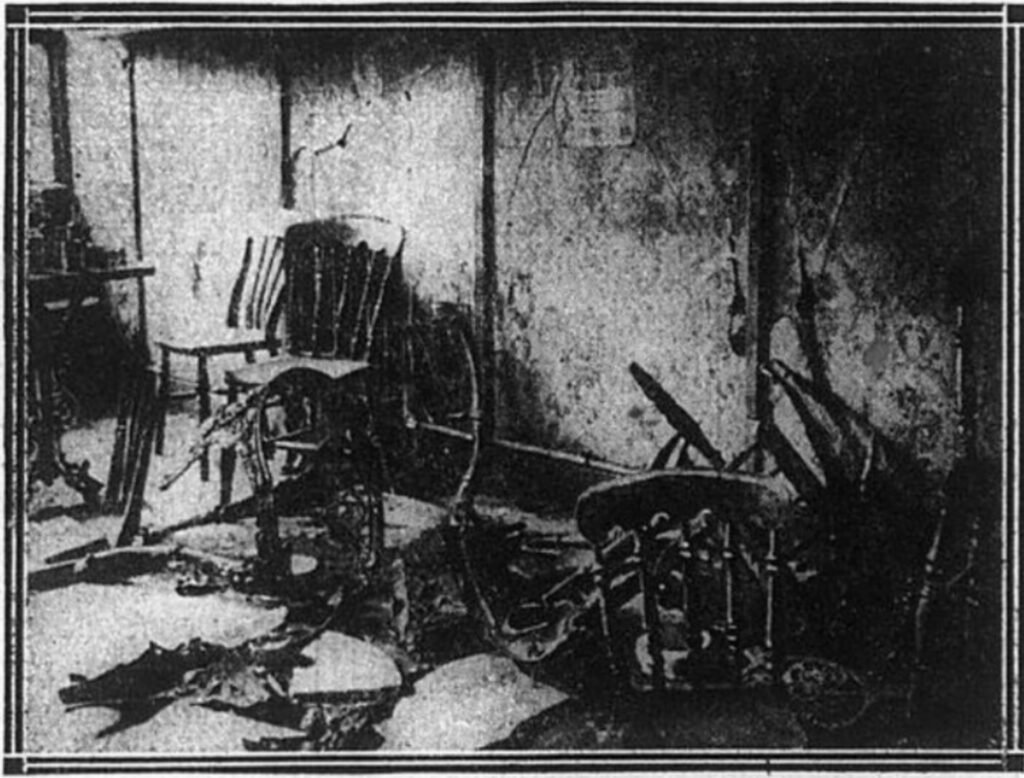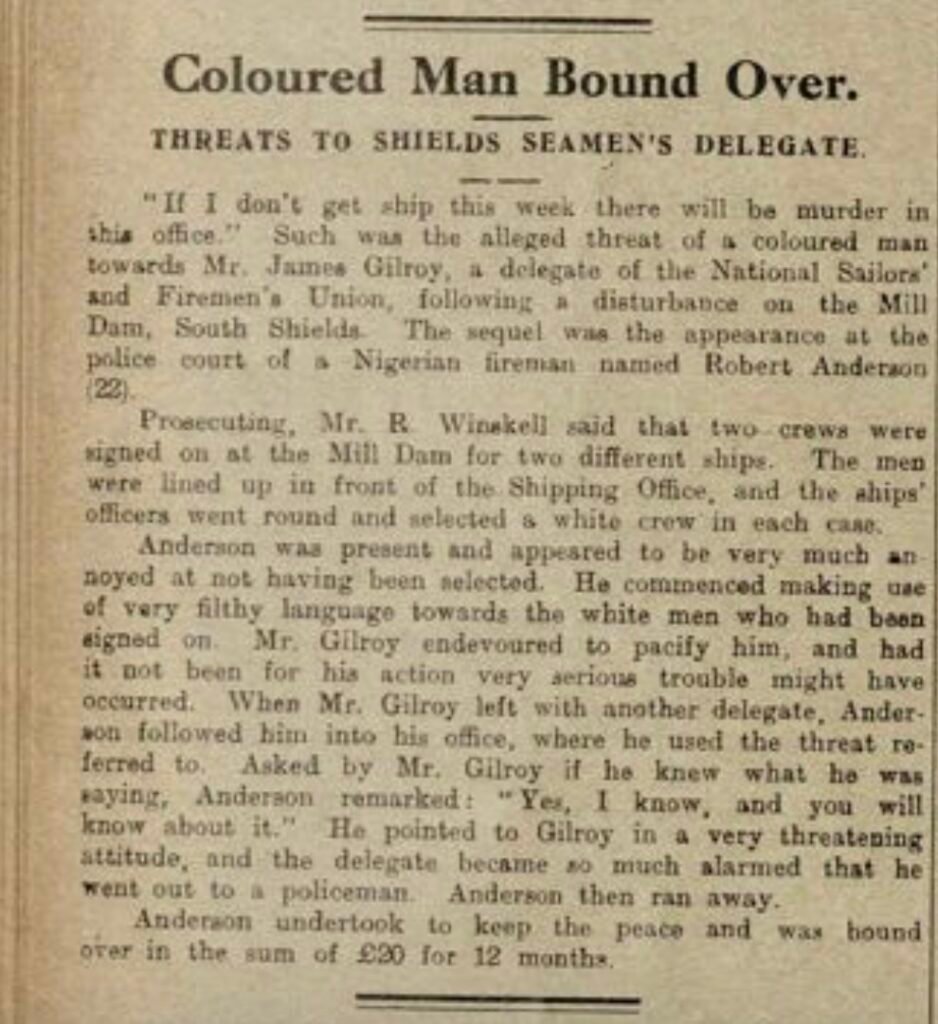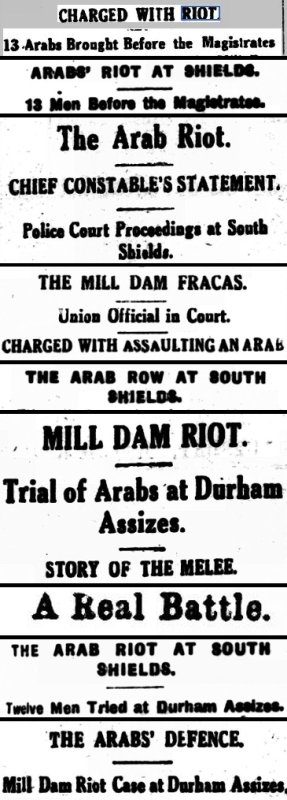
1919 Riots
1919 Riots
Often termed ‘Arab riots’ which is a misleading and politically convenient description, the violence which broke out on the 4th of February 1919 was part of a co-ordinated attack against the Arab community. Around the same time, there were also riots in Glasgow, Newport, Cardiff, Liverpool, London and Hull. An apt summary of the events on the 4th of February 1919 is that “In 1919, white residents of South Shields attacked Arab boarding houses and cafes. At Mill Dam, where seamen signed up for work on ships, a white man shouted a racial slur at a Yemeni seaman waiting to sign on. After the conflict that ensued, eight Yemeni seamen were imprisoned.”1
Global Contributing factors
The root causes were complex, involving a post-war decline in shipping resulting in economic anxiety. Also, union politics, discrimination from unions such as the National Union of Seamen (who actively campaigned against a section of its own membership for nearly 2 decades), and long-standing racial prejudice. An example from the 1919 edition being shown below:

“At the end of the First World War, the demobilisation of troops caused severe post-war competition for jobs. The perception that foreigners were ‘stealing’ jobs was one of the triggers for the rioting and attacks on black and minority ethnic communities in British port cities.”2

(c) Western Mail 14/06/1919 – Cardiff
The TUC (Trades Union Congress) passed a resolution in September 1919 demanding “immediate steps be taken to abolish all underpaid Asiatic labour in the mercantile marine, and that preference of employment be given, first to white, then to British coloured, in preference to Chinamen”.3
Provocation – the build up
Richard Lawless states:
“In January 1919 a large crowd of white men, including ex-soldiers attacked an Arab shop in Waterloo Vale in South Shields smashing all the windows, pulling out the gas fittings and causing a tremendous amount of damage. The attack appears to have been part of a pre-arranged plan.” 4
“There were further clashes the next day as a white mob pursued and assaulted a number of Arab seamen who defended themselves with sticks and other weapons. When the police intervened and attempted to (…) disperse the crowd, which numbered over 200 people, one of the white mob shouted ‘We are white people; stay where you are’. 5
A few days later a white mob attacked an Arab boarding house belonging to Abdul Magid, breaking the shop windows and smashing the furniture.”6
These quotes from book ‘From Taiz to Tyneside’ clearly show extreme provocation by the local population to a community who in earlier years, during World War One, had fought side by side with them.
‘The Socialist Worker’ online article has this narrative of events:
“In February nine Arab stokers signed on to a ship in South Shields, near Newcastle. They went to the NSFU (The National Sailors’ and Firemen’s Union) union office to pay their dues.
However, NSFU union official James Gilroy told bosses there would be “bloodshed” if the men—members of his own union—were hired.
He got the ship to hire a new set of white workers.
A crowd of about 200 chased the Arabs into the area where they lived and about 50 local black people came to their aid.
The authorities called in the army to end the fighting”7.
John Fye, ship engineers and boarding house masters.
The practice wherein ship engineers undercut white seamen and gave first refusal to the Arabs in many instances, who they regarded as cheaper labour, was a major contributing factor to the ill feeling that existed at this time. in South Shields. Ship engineers were known to have direct links with boarding house masters and would go to boarding houses and arrange crews for their ships ahead of time. This pushed white seamen out of the equation. At a time with no welfare state, people were fighting to survive and this situation was ultimately exploited by shipping engineers who had the complete liberty to choose their own crews.
The riots documented as being on the 4th of February 1919 are recorded as having been instigated by an official of the ‘Cooks and Stewards’ Union’ “who is reported to have shouted to the crowd, ‘Don’t let these Arabs sign on the ship’ and ‘Come out you black _____ You are not going to join the ship’. 8 This official was John Fye.
“The first Riot took place when in 1919 some Arab Seamen, having just paid their £ 2 stamp to clear their union book, which had to be paid up to date before they could sail, were then refused work. Fye himself hit one of the Arabs, who hit him back…the crown then chased the Arabs all the way Holborn, the district in South shields where they lived. Here Friends of the Arabs arrived to back them up. They fired warning shots over the heads of the attackers, then they turned the tables on them chasing the attackers through the streets back to the Shipping Office, which was wrecked in the following fight. Army and Navy patrols were called in and 12 of the Arabs were arrested. At Durham assizes the judge was reasonably lenient. Three were acquitted, others received between three months prison and one month hard Labour.”9
“One of the Arabs asked Fye why they could not join the ship when they had paid their union subscription and he is reported to have replied, ‘You black _______ this ship is not for you.’ The Arab seaman was so provoked that he struck Fye with his hand. Fye retaliated (…) from this incident a a fierce conflict developed.”10
Consequences for Fye and Arabs

(c) British newspaper archives 1919
“At the trial the prosecution argued that Fye’s language to a crowd anxious for employment was like ‘the dropping of a match into a keg of gunpowder’. Had it not been for his remarks to the crowd, there would have been no incident. 11
Of course, from a speculative point of view it can be considered inevitable that this situation was a bubble bound to burst. The riots in other cities demonstrate that this issue was not isolated to South Shields. The issue was nationwide and based on global factors.
“ Fye was ordered to be bound over for twelve months but the charge of assault was dismissed. No other white men were arrested or charged. Eventually twelve Arabs were committed to Durham assizes for trial. Three were found not guilty and discharged. The rest were sentenced to imprisonment for between one and three months.” 12
In essence, 9 Arabs were imprisoned, 3 acquitted; John B. Fye bound over for breach of peace
Ultimately, the riots did not break out overnight and were not purely based on race though it is undeniable that racial superiority had a definite role in the attacks on the Arab community. What is clear based on the evidence, is that the Yemenis did not just simply decide to go rioting which the name ‘Arab riots’ suggests.
- Dixon, E. (2019). True North – The Delacorte Review. [online] The Delacorte Review – Real true stories (and how they happen). Available at: https://delacortereview.org/2019/02/17/true-north/ [Accessed 3 Aug. 2025].
↩︎ - Archives, T.N. (n.d.). The National Archives – Homepage. [online] The National Archives. Available at: https://www.nationalarchives.gov.uk/education/resources/1919-race-riots/ ↩︎
- unknown (2019). 1919 race riots in Britain—a legacy of empire – Socialist Worker. [online] Socialist Worker. Available at: https://socialistworker.co.uk/in-depth/1919-race-riots-in-britain-a-legacy-of-empire/ [Accessed 3 Aug. 2025]
↩︎ - Lawless, R.I. (1995). From Taʻizz to Tyneside. p. 79 ↩︎
- Ibid., p. 79-80 ↩︎
- Lawless, R.I. (1995). From Taʻizz to Tyneside. p. 80 ↩︎
- unknown (2019). 1919 race riots in Britain—a legacy of empire – Socialist Worker. [online] Socialist Worker. Available at: https://socialistworker.co.uk/in-depth/1919-race-riots-in-britain-a-legacy-of-empire/ [Accessed 3 Aug. 2025] ↩︎
- Lawless, R.I. (1995). From Taʻizz to Tyneside p. 80 ↩︎
- Britain, in (2010). Black Britons – Race Riots in South Shields and Liverpool. [online] The Black Presence in Britain. Available at: https://blackpresence.co.uk/black-britons-race-riots-in-south-shields-and-liverpool/. ↩︎
- Lawless, R.I. (1995). From Taʻizz to Tyneside. p. 35 ↩︎
- Ibid., 82 ↩︎
- Ibid., 82-83 ↩︎
